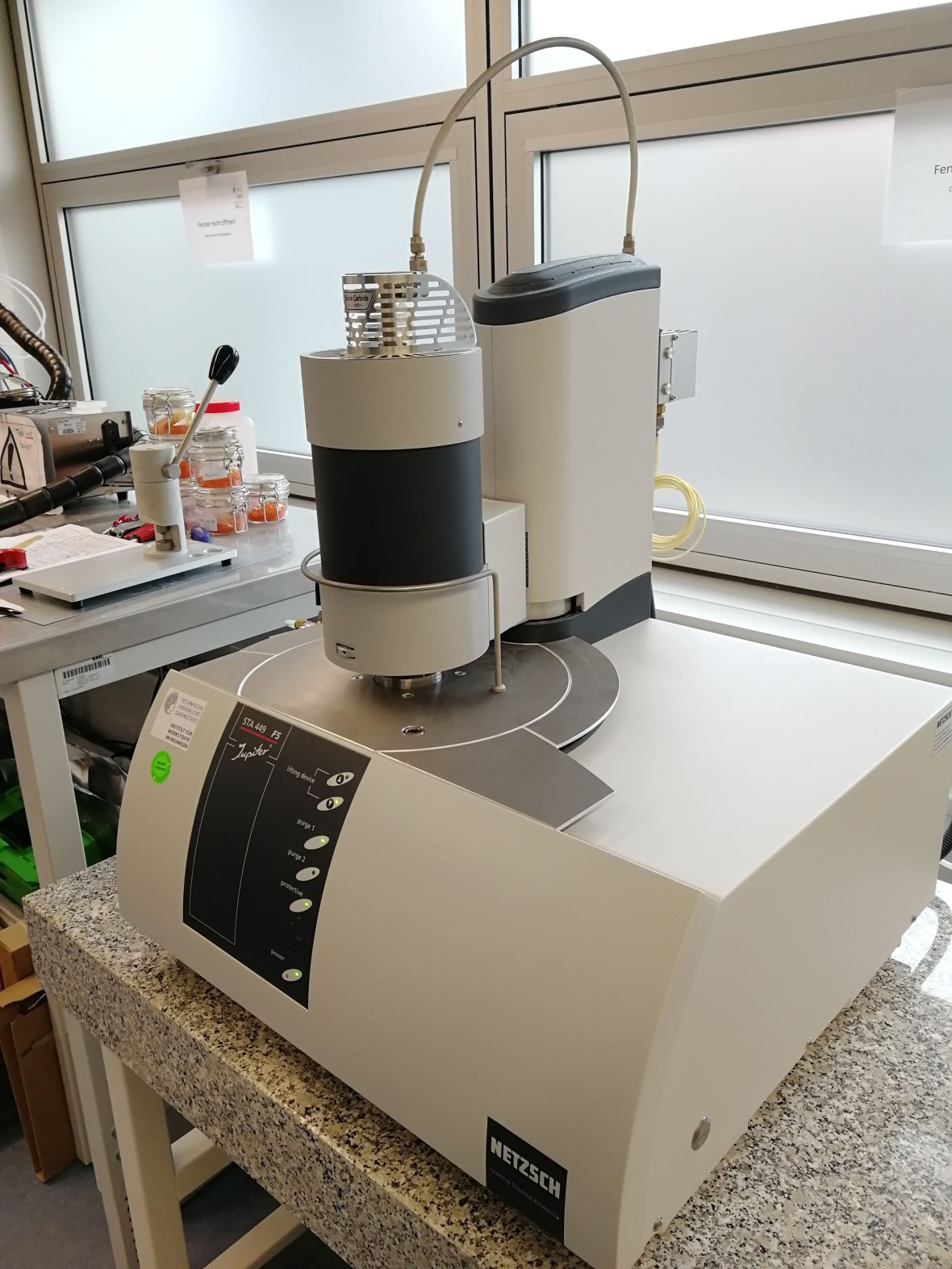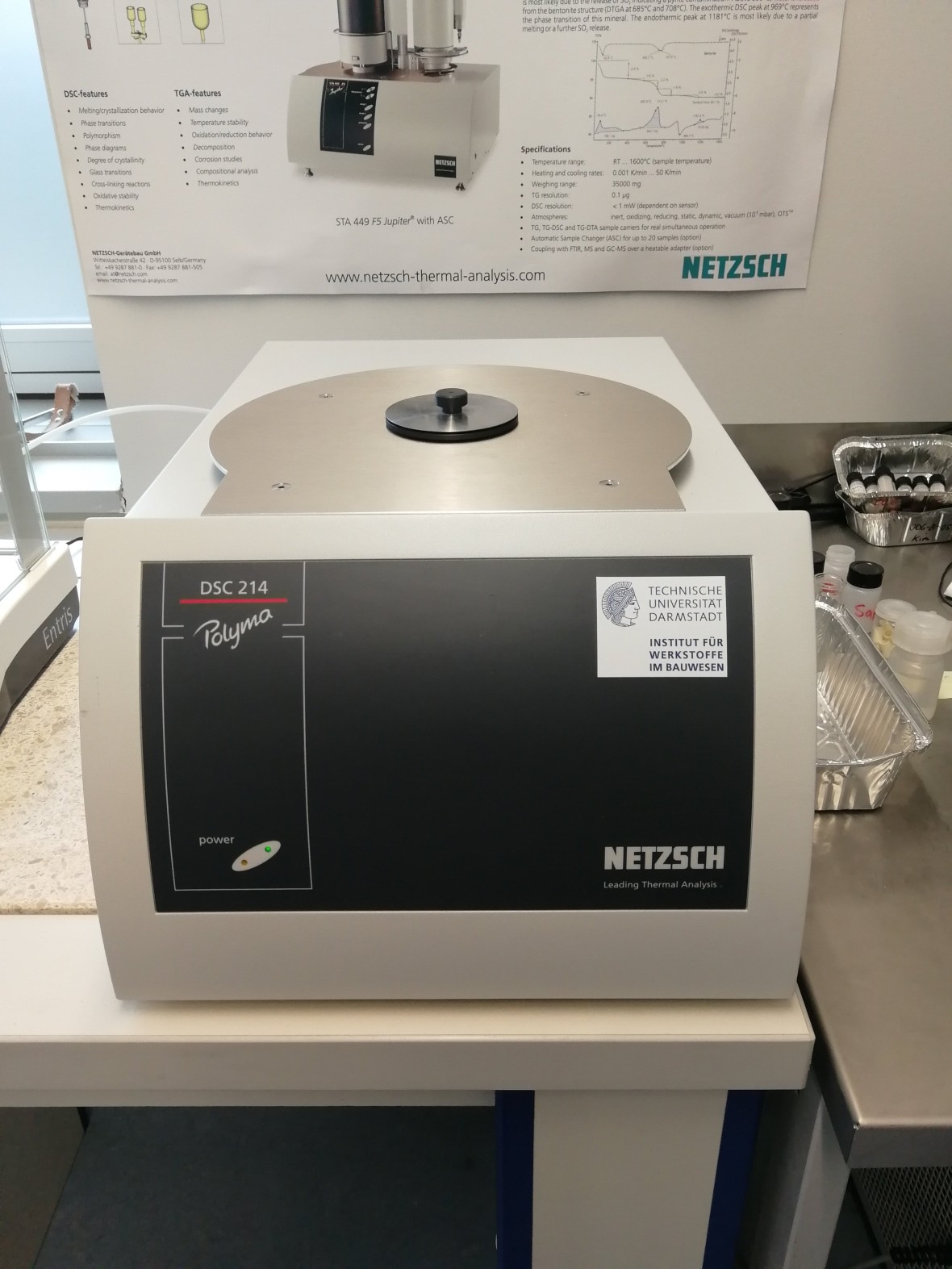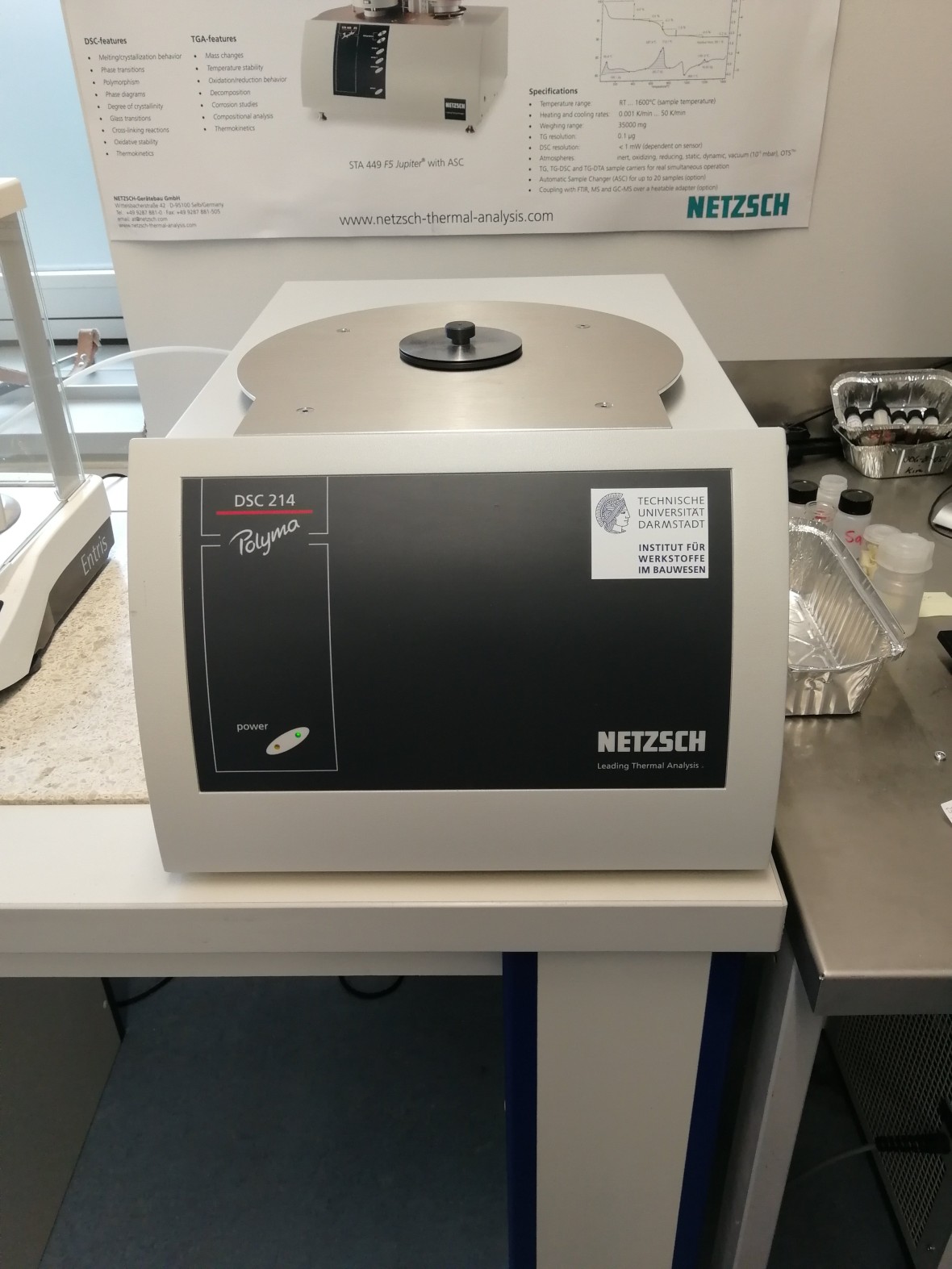Atmospheric scanning electron microscopy
Model:
Zeiss EVO LS25 – Atmospheric scanning electron microscope
Short description:
The atmospheric scanning electron microscope (AREM) generates a beam of electrons. Electrons from the beam hit sample atoms and generate measurable interactions. These interactions can be used for imaging. Furthermore, spatially resolved, chemical surface analysis is possible using the built-in energy dispersive X-ray spectroscopy (EDAX).
Measurement of:
Surface morphology, (semiquantitative) chemical composition (point measurements, area measurements), distance measurements, qualitative and quantitative pore analysis.
Special features:
- working in high and low vacuum
- large sample sizes (up to 210 mm height)
- max. lateral resolution of 500 nm
- Heating module
- Tension-compression module
- Peltier element (cooling table)
X-ray diffraction (XRD)
Model:
Bruker D2 Phaser – X-ray diffractometer
Short description:
X-rays, like visible light, are electromagnetic waves. The short wavelength of X-rays allows diffraction and reflection from lattice planes of minerals. These lattice planes diffract the incoming X-rays characteristically for each mineral, depending on its chemical composition and crystal structure. The intensities and diffraction angles can be used to identify crystalline mineral phases.
Measurement of:
Mineral phases in solid mixtures (qualitative and quantitative).
Fourier-Transform-Infrared Spectrometer
Model:
Invenio R FTIR spectrometer with an ATR unit and MIR-FIR spectral range extension (Bruker Optik GmbH).
Short description:
Fourier-transform-infrared-spectroscopy is an analytical method that uses infrared radiation (ranging from 800 nm to 1 mm wavelength) to excite different energy states in molecules. Solid an liquid samples can be examined by means of FTIR. An infrared beam (with various wavelengths) is directed at the sample. Through the absorption of different wavelengths by the sample, molecules are identifiable. From this, the chemical composition can be qualified and partially quantified. This investigation method can be used as a complementary method to our other chemical-mineralogical investigations (e. g. for X-ray amorphous material)
Measurement of:
Qualification and quantification of chemical composition from crystalline and amorphous material, in-situ phase change and solid state reaction
Thermogravimetrie (TGA)
Model:
STA 449 F5 Jupiter (Netzsch)
Short description:
Simultaneous Thermal Analysis (STA) refers to the simultaneous application of thermogravimetry (TG) and differential thermal analysis (DTA) to the same sample in the same instrument. The measurement conditions in STA are completely identical for the TG and DTA signals. TGA is often used to determine the composition of mineral binders, for an evaluation of their reactivity potential, and as a complementary analysis to XRD to complete the phase analysis.
Measurement of:
Mass changes, temperature stability, oxidation/reduction behavior, decomposition, corrosion, quantitative chemical composition
Testing possibilities according to:
ISO 11358, ASTM D3895, DIN 51004, DIN 51006, DIN 51007
Isothermal reaction calorimetry
Model:
Isothermal reaction calorimeter MC CAL from C3 Prozess- und Analysentechnik
Short description:
By means of reaction calorimetric measurement, the enthalpy of reaction of the exothermic hydration process of cement can be recorded in detail according to DIN EN 196-8. Reaction calorimetry offers a direct approach to measuring temperature changes caused by any type of reaction. It can therefore be applied to a large number of research questions and often completes the material-technological picture of a substance.
Measurement of:
Heat release of hydraulic binders, determination of setting behavior, hydration process
Special features:
- 12 measuring channels for parallel measurements
- Mixing cell for mixing the sample with water directly in the sample chamber to record even the earliest reactions (< 30 sec)
- Sample volume: 20 ml
- Measuring range: ± 2 W dynamic
- Temperature range: 5-90 °C
- Temperature stability: ± 0.01 °C
- Limit detectability (abs.): 20 μW
- Accuracy: ± 25 μW
Differential Scanning Calorimetry (DSC)
Model:
DSC 214 Polyma (Netzsch)
Short description
“Differential Scanning Calorimetry” (DSC) is a thermal analysis method for measuring the amount of heat given off or absorbed by a sample during heating, cooling or during an isothermal process. In building physics, the method is used, among other things, to determine melting and glass transition temperatures or the specific heat capacity.
In addition, a phase change of a material can be identified via heat absorption or release. Thus, the exact temperature of the phase change as well as the amount of energy converted in the process can be quantified.
Measurement of:
Char. Temperatures, Enthalpies, Crystallinity, Oxidation stability, Degree of cure, Eutectic purity, Specific heat, Molecular weight distribution.
Testing possibilities according to:
DIN EN ISO 11357, ASTM D3417, ASTM D3418, ASTM D4591, ASTM E793, ASTM E794, ASTM E1356, ASTM F2625, DIN 51007, DIN 53545, EN 61074 (IEC 1074), IEC 1006, ASTM D3350, ASTM D3895, DS 2131.2, DIN EN 728, ISO 11409, DIN 65467
Laser Granulometry
Lasergranulometer
Model:
Partica LA-950V2 von Horiba (Retzsch)
Short description:
A laser granulometer can be used to determine the particle size distribution of ultra-fine powders by means of light refraction on very small particles. In this way, it is possible to optimize the packing density of the fines and the binder in a concrete. This is one of the technologies crucial to the production of modern high-performance concretes (HPC, UHPC). Only by eliminating the smallest voids in the cement paste are the high densities, strengths and durability of modern concretes possible.
Measurement of:
Particle size distribution (0.1 µm to 3.00 mm), Quantile values of particle sizes, Specific surface area.
Necessary input variables
- Refractive index of the investigated substance
- Refractive index of the dispersing medium
Requirements for investigated substances:
- Solid particles with diameters from 0.1 μm to 3.0 mm
- The bulk density should be at least 800 kg/m³
Mercury Porosimetry (MIP)
Model:
Pascal 140 von ThermoFisher Scientific
Short description:
The mercury (pressure) porosimetry (MIP, mercury intrusion porosimetry) technique is based on the pressure-dependent intrusion of evacuated pores by non-wetting mercury. Under the simplifying assumption that the pores of the investigated material have a cylindrical shape, a specific pore size is assigned to each working pressure. The results are output graphically and in tabular form. The pore radii are usually plotted on a logarithmic scale. The derivative of the pore volume sum curve by the logarithm of the pore radius gives the differential pore size distribution curve.
Measurement of:
Pore size and pore volume, pore size distribution, bulk density, specific surface area
Helium pycnometer
Model:
Pyknomatik-ATC von ThermoFisher Scientific
Short description:
The helium pycnometer can be used to determine the pure density of solids very accurately. If this is known, porosities can be calculated from it with high precision. For this purpose, material samples are finely weighed and then filled with helium in a sample chamber with a defined volume. The amount of helium provides information about the pore space or the solid content.
Measurement of:
Pore volume, pure density
Tension / compression module
Model:
Tension/compression module from Kammrath Weiss
Short description
With the handbag-sized mechanical tension/compression module, both force- and displacementcontrolled tests up to a maximum of 5 kN can be performed. Cyclic loads and long-term measurements are also possible. Thanks to its small dimensions, it can be installed in the AREM. Thus, in addition to the mechanical recording of load curves, crack formation and crack propagation in the material even in the size range of micrometers can be recorded by means of imaging.
Measurement of:
- Force range: 1 µN to 5 kN
- Specimens (maximum dimensions): 60 mm x 10 mm x 5 mm
- Speeds: 0.3 to 50 µm/sec
- Tension/compression displacement: max. 45 mm
- Displacement measurement: linear encoder; resolution: 100 nm
- Connection: 230/110 V / 50Hz
- Dimensions in mm (LxWxH): approx. 200 x 150 x 55
Light Microscopy
Model:
Stereomicroscope (VHX-600, Keyence)
Short description:
Imaging examinations are possible using light microscopy. The VHX-600 stereo microscope from Keyence has two interchangeable objectives (25x to 200x magnification and 500x to 2000x magnification). In addition, the device is connected to a computer and can store the images digitally. Furthermore, the lens can be controlled by a motor. This allows images to be taken over several mm without losing depth of field. This is also used for the automatic measurement of pores.
The software allows several possibilities of length, area and surface measurement.





























